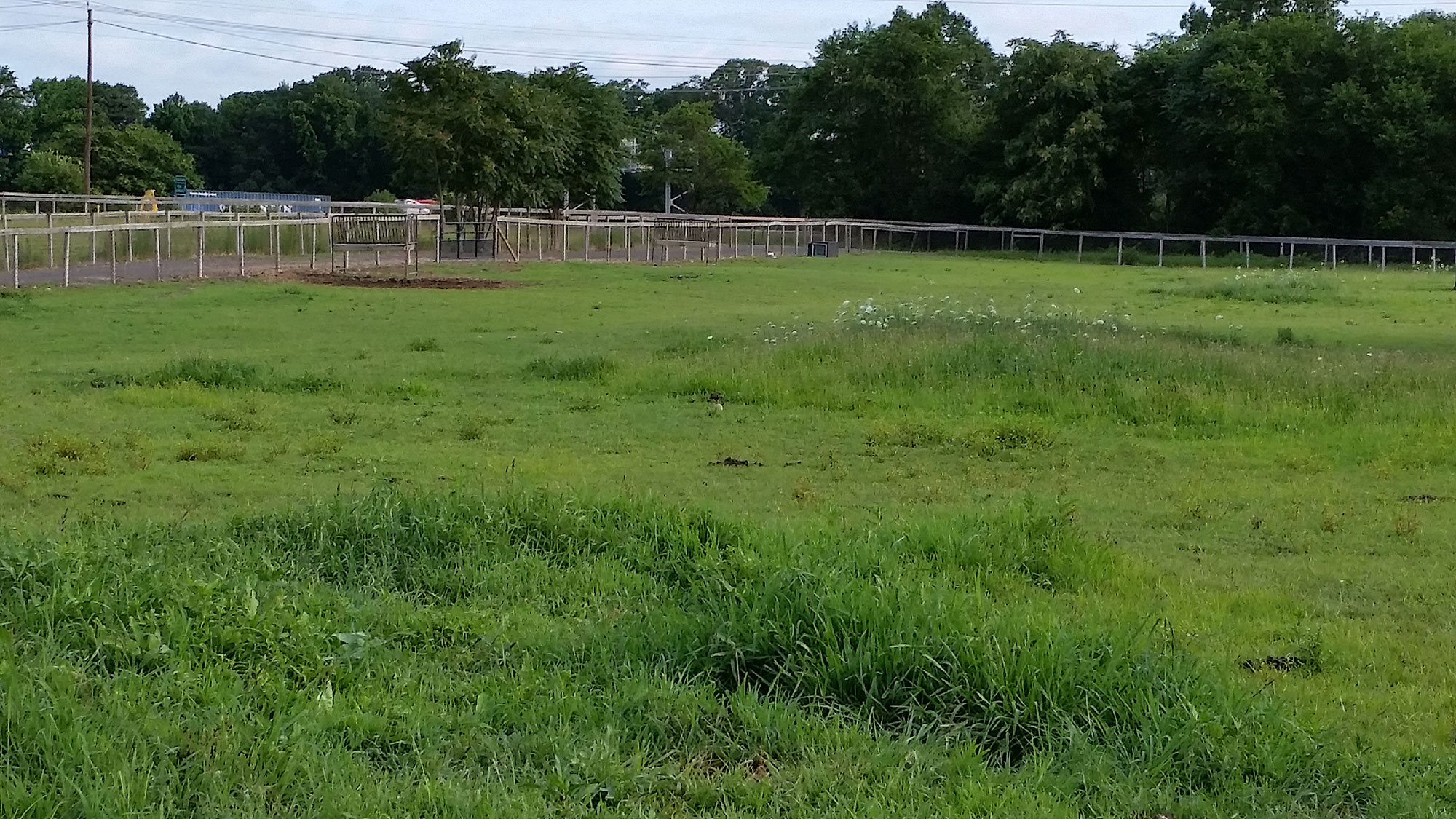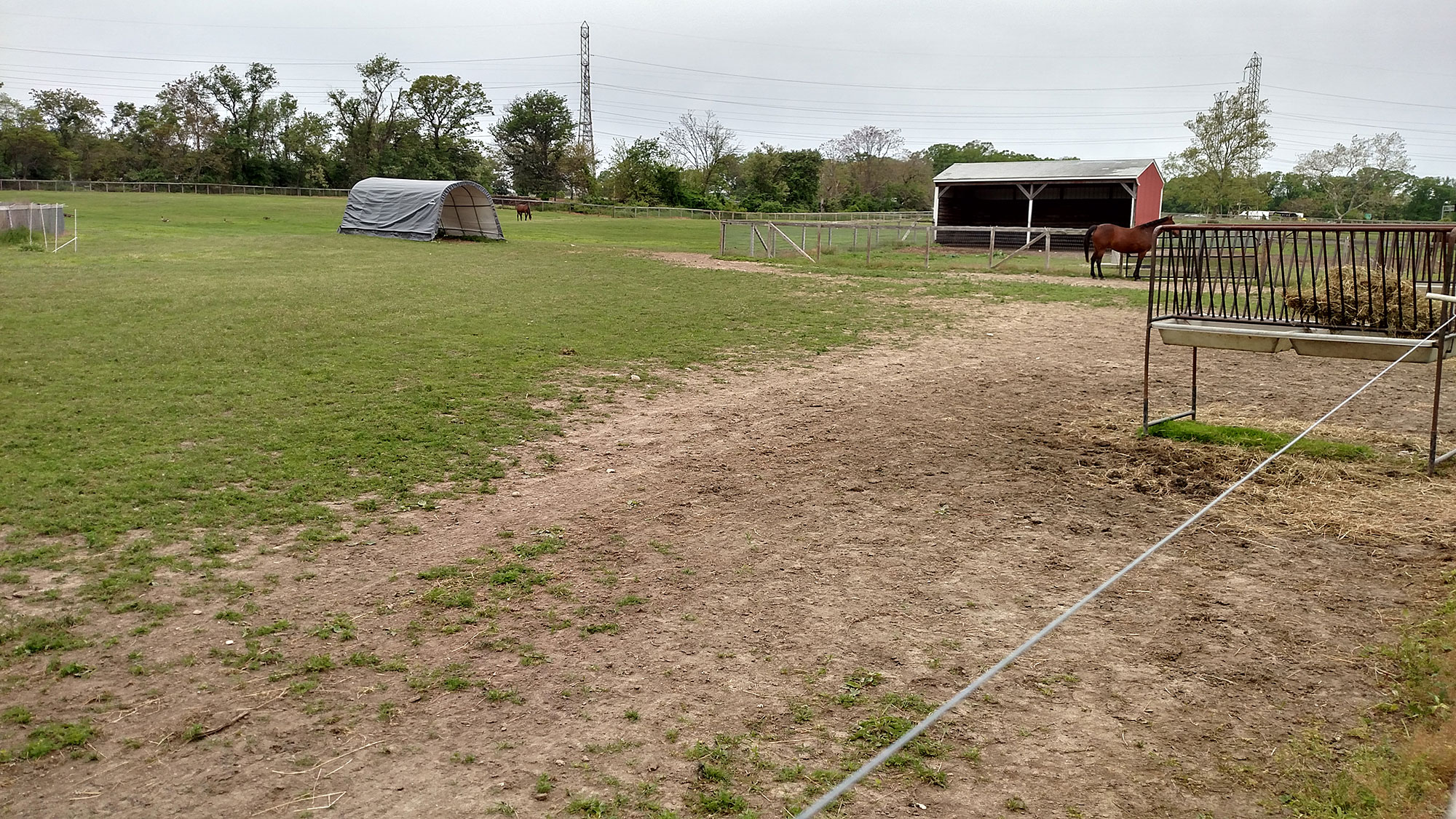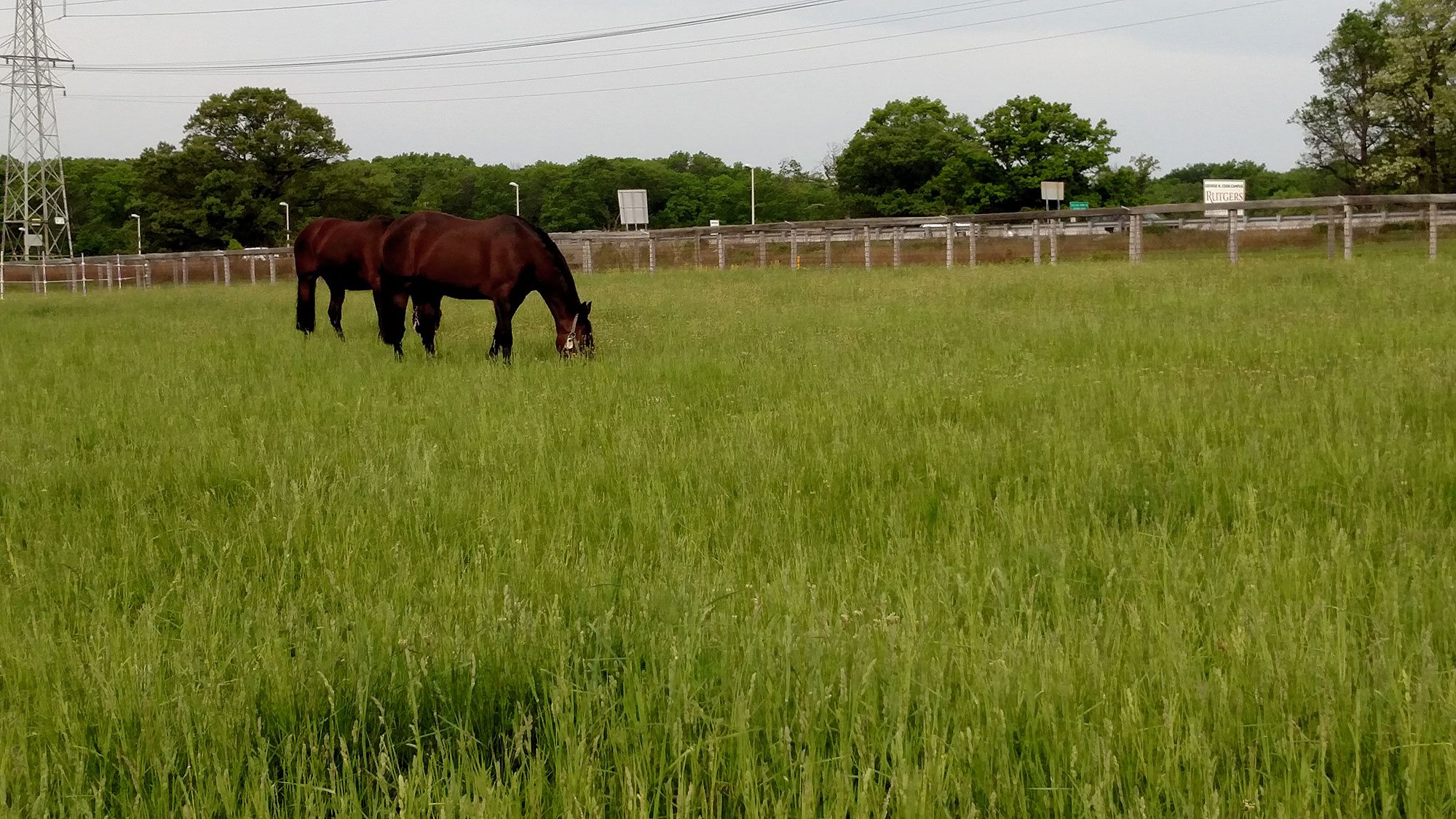Anna Fojtik, Undergraduate Student, Department of Animal Sciences
Carey Williams, Extension Specialist in Equine Management
Let’s face it: there is no such thing as a perfect, maintenance-free pasture. There will always be those areas that the horses will not eat (roughs) and the patches that are overgrazed (lawns) as shown in Figure 1. Therefore, there will always be the need for some pasture maintenance to keep the grasses productive and your horses happy. However, understanding how climate and grazing pressure affects various grasses; which grasses create the best mixture for your pasture; and even what grasses your horses prefer, can all contribute to more efficient equine pasture management.
Taking into account which grasses a horse prefers is probably not on top of one’s list when it comes to pasture management, but it can be a key to a more efficient pasture. Recent studies have shown that horses do indeed have preferences for certain grass species, which means significant consequences for growth of forage and overall pasture management if ignored.

Figure 1. Unevenly grazed pasture. (Courtesy of L. Kenny)
The Effects of Overgrazing
Overgrazed patches can lead to more pronounced changes over time. They can eventually turn into patches of bare ground because the grasses in that area do not have enough time to rest and regrow. Even if the grasses begin to regrow, as long as the horses are allowed to continually graze that area, they will keep selecting the new growth and will eventually kill the grass plant.
One way to minimize the effects of overgrazing is to implement a rotational grazing system, which moves a herd of horses between several pastures in such a way that grasses are allowed to rest and regrow between grazings, which allows for the regeneration of nutritious plant leaf tissue (see RCE fact sheet FS368, “Establishing and Managing Horse Pastures”). Research performed at Rutgers University (Kenny, 2016) showed clear differences between continuous and rotational systems (see Figures 2 and 3) as well as research from University of Tennessee (McIntosh et al., 2015). Forage nutrient content declines during the grazing period and recovers during the rest period as long as the roots are left intact and the forage has not been overgrazed.

Figure 2. From the Rutgers continuous grazing research pastures in May, 2016 after nearly 2 years of continuous grazing. Bare patches are visible around the feeder and fence lines. Remaining patches of grass are overgrazed. (Courtesy of C. Williams.)

Figure 3. Rotational grazing research pastures image taken same day as Figure 2. (Courtesy of C. Williams.)
Not only is the loss of vegetative cover unsightly and unhealthy for pasture plants, it can lead to changes in grass species composition of the pasture over time. When grasses are exposed to various environmental factors and put under the stress of grazing, some species do not persist as well as others. The overgrazed grasses fail and eventually the composition of the pasture becomes dominated by the more persistent and less grazed grasses, or even weeds. Further, the persistence of certain grasses can also depend on the stage of growth in which the grass is grazed. During the vegetative (leafy) stage of growth, the grass plant’s main growth point is right above the ground, making it less accessible to grazing. However, when grasses are grazed in the stem elongation phase, they tend to not persist as well because the growth point rises up the stem and can easily be removed by grazing. Also, some grasses store energy reserves for regrowth in the crown of the plant, right above the soil surface. Grazing these plants below three inches will remove the energy reserves and they will be much slower to regrow, if they regrow at all. Figure 4 depicts a growth curve for grasses depending on plant height.

Figure 4. Growth curve for grasses depending on plant height. (Courtesy of C. Williams.)
When planting a mixture of grasses in horse pastures, owners need to consider that after a year or two, the desired grasses may not be as abundant as other grasses, which could require a change in pasture management strategies. Owners might also have to take into account what nutrients this “changed” pasture might have to offer the horse (for example, if grasses have been replaced by unpalatable weeds or high-protein clover) and act accordingly by supplementing their diets to meet their nutrient requirements.
Four Things to Consider for Efficient Pastures
1. Climate and heavy grazing effects on certain grass species
When deliberating what types of grasses to plant in a pasture, there are a couple of things to consider. First, you need to consider whether the grasses you plant will withstand the environment (i.e., soil type and conditions) and climate of the area where the pasture is located. The type of soil you seed your grasses in is important to consider. Kentucky bluegrass seems to do well in soil that is moderate to well-draining. Tall fescue also does well in moderate to well-drained, infertile soil. Orchard grass is adapted to well-drained soils as well. Loam soil, a mixture of clay, silt, and sand, absorbs nutrients well and offers good water drainage, making it an ideal choice for planting the above mentioned grasses. Luckily, most of New Jersey contains some variant of loam soil depending on the county you live in.
In New Jersey and the surrounding northeastern states, planting warm season grasses would not make sense. The climate is not warm enough for those grasses to flourish. Therefore, horse pastures in this area are mostly cool season grasses like Kentucky bluegrass, orchard grass, smooth bromegrass, and tall fescue. However, not all species are as productive under the stress of intense grazing. Studies at the University of Minnesota (Martinson et al., 2016) have shown that orchardgrass and tall fescue perform best during horse grazing compared to timothy and creeping foxtail. This could be due to level of maturity (or height) of the grasses when they are grazed. Grasses such as timothy or smooth bromegrass do not persist well if grazed during the stem elongation phase, which is when most pastures are grazed. The loss of carbohydrate root reserves and removal of stems that contribute to growth during the elongation phase make these types of grasses less desirable for equine pastures.
2. Combination of grass species in your pasture seeding mixture
Another thing to consider is what mixtures of grass species you want to plant so that all grasses can contribute to a productive pasture. Growing monocultures (a single species of grass in the pasture) is not recommended even though a certain species of grass, like orchardgrass, may be consistently a high yielding species. The concept of “not putting all of your eggs in one basket” applies here.
Forage mixtures planted in pastures offer many benefits. Because mixtures are better adapted to diverse environments, they tend to yield more compared to monocultures, better suppress weeds, and have positive effects on forage nutritive value. Mixtures also provide security against total loss during harsh conditions including extreme cold, frost over the winter, or drought in the summer. The presence of various species allows the pasture to adapt and remain productive. Choosing the right mixture of grasses based on environment and tolerance of grazing pressure can lower pasture maintenance and keep a pasture productive.
3. Grasses your horses prefer to eat
What does horse preference of grass species have to do with pasture management? Preference ultimately affects the way horses will utilize the mixture of grasses and the balance of species within this mixture, especially if certain species are grazed repeatedly. Because horses do prefer certain grasses, they will end up grazing those specific areas repeatedly, creating overgrazed patches. Not only does this cause a problem for the grasses in overgrazed areas in terms of growth and survival, but also contributes to added pasture maintenance. In a study done at the University of Minnesota, horses preferred grass mixtures containing Kentucky bluegrass, timothy, perennial ryegrass, and tall fescue compared to mixtures containing a majority of orchardgrass.
4. Implementing a grazing strategy
Often the right mixture of grasses still might not be enough for a productive pasture. Implementing a grazing strategy will help both the pasture and the horse. As mentioned before, continuous grazing creates immense grazing pressure that can lead to bare patches and loss of nutrients in the grasses. A rotational grazing system works to relieve the grazing pressure and allows grasses to replenish leaf area.
Many benefits have been found using a rotational grazing system. Grasses within a rotational grazing system have higher digestible energy in the form of soluble carbohydrates (i.e., sugars and starches). These soluble carbohydrates are easily broken down to glucose which is one of the main sources of energy for horses. Energy is essential to promoting growth and performance, and pastures with a higher amount of energy are ideal for most horses. However, if you have a horse that is prone to metabolic problems like reoccurring colic or laminitis, this might not be the best situation. In this case a veterinarian or nutritionist should be called to make a recommendation in the horse’s best interest.
Rotational grazing can also save in grain costs and lead to a more sustainable farm system. A pasture with low stocking density (number of horses per acre), a mixture of species that are high yielding, and management that results in ≥70% vegetative cover can result in maximum forage yield and quality. This high yield and quality may also allow hay to be harvested from the site, ultimately lowering feeding costs. Overall, a rotational grazing system is preferred over a continuous grazing system because of improved forage production, and therefore less weed cover and muddy areas.
Overall Recommendations for Effective Grazing
Taking into account all of these factors, which grasses can create the best mix that offers the best choices to your horse while still being a productive pasture with minimal maintenance? It is inevitable that certain species within a mixture will decline over time under continuous grazing. However, mixtures still serve an important role in pasture management. Orchardgrass and tall fescue produce high yields, Kentucky bluegrass is persistent under horse grazing, and perennial ryegrass and timothy provide forage that is highly preferred by horses. It is important to note that timothy, in large proportions, may not be the best option for pastures due to its inability to withstand grazing pressure, and because it is prone to a pest called ‘cereal rust mite’ which may shorten the life of timothy. Tall fescue and Kentucky bluegrass tend to be preferred by horses and persist under grazing pressure. For additional yield, owners can add orchardgrass. Although it is not as preferred, horses will graze it when the other grasses are consumed. Therefore, in New Jersey the best mixture of cool season grasses in a horse pasture include tall fescue (endophyte-free or -friendly variety), orchardgrass, and Kentucky bluegrass.
A correct mixture of pasture grasses and a rotational grazing strategy can lead to a productive pasture. Considering several factors, including how grasses grow throughout the season; which grasses do better under the stress of grazing; and which are preferred by your horse, can all help create more productive pastures. Choosing the correct mixture for your pasture can reduce unsightly overgrazed patches; offer the best possible nutrition for your horse; as well as reduce the costs involved in pasture maintenance. Implementing a rotational grazing system can also help in reducing overgrazed patches and can offer more nutrition for your horse. A more uniformly-grazed pasture with correct forage mixtures leads to higher animal productivity and utilization of forage available, as well as lower costs of pasture management. Horses are picky eaters but knowing what their palates prefer can lead to a more productive pasture, a healthier horse, and a happier owner.
